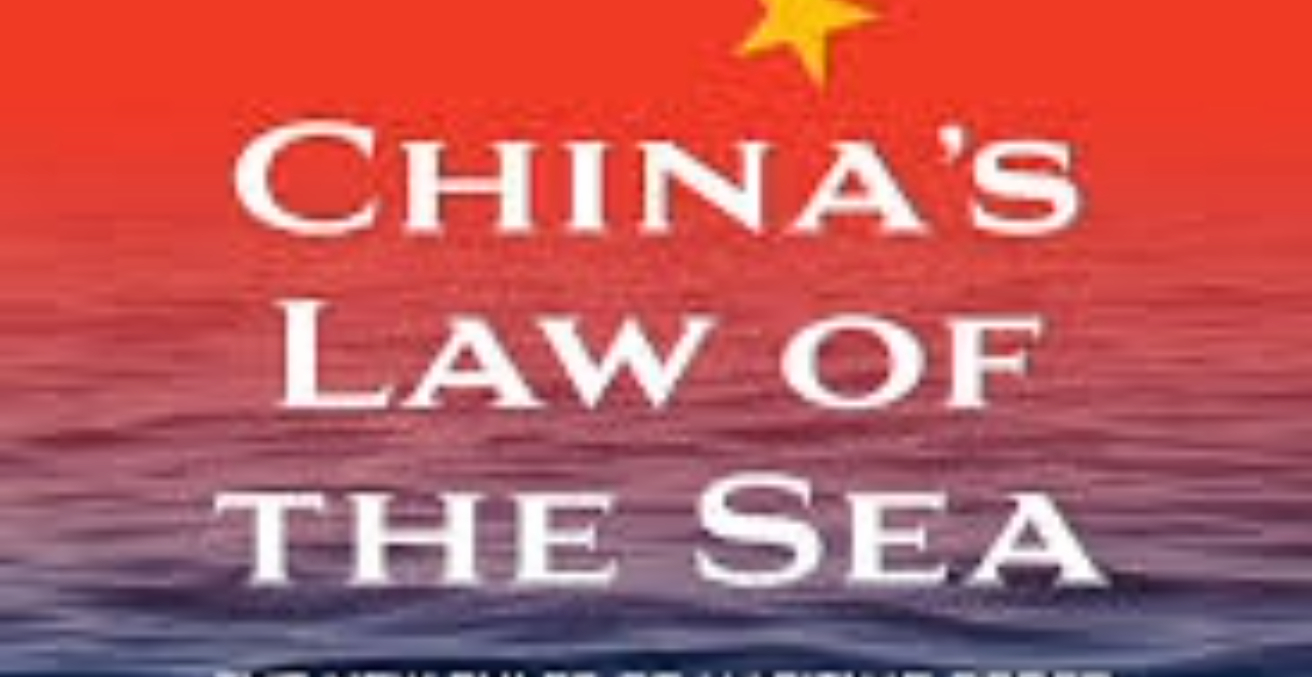Isaac B. Kardon’s China’s Law of the Sea offers a comprehensive analysis of how China is reshaping maritime norms through its selective interpretation of international law. By examining Beijing’s approaches to geographic claims, resource rights, navigation rules, and dispute resolution, Kardon reveals a fragmented but strategic challenge to the UNCLOS-based order.
Many scholars and policymakers often say the People’s Republic of China (PRC) is challenging the existing international rules-based order in the contested maritime areas such as the South China Sea. However, what does this mean and how is China posing a threat to the international rules-based order? Isaac B. Kardon’s China’s Law of the Sea: The New Rules of Maritime Order answers this question by investigating China’s rule shaping in the maritime realm. In particular, he examines how Beijing is interacting with the United Nations Convention on the Law of the Sea (UNCLOS) and how it promotes its own preferred rules in relation to UNCLOS.
Kardon’s book consists of six chapters, each discussing different components of China’s preferred maritime rules. Before presenting his findings, he introduces his framework and methodology. In terms of framework, Kardon argues that rules are a key component of international order, and thus, investigating China’s preferred maritime order requires an examination of its preferred rules. This approach is not unique, as scholars of international order often use rules as indicators of order.
Kardon also outlines two pathways for changing the rules within UNCLOS, a key body of international maritime law. He contends that similar to other forms of international law, UNCLOS consists of treaty rules and customary rules. This means that changes to UNCLOS can be achieved by influencing either the “interpretation and application of the treaty” or “customary practices.” This distinction directly shapes the research methodology in Kardon’s book. He tests the uniformity and consistency of the PRC’s practice of these rules and observes whether rule-affected states have acknowledged them. This analysis is conducted primarily through qualitative methods and case studies.
After introducing his methodology and framework, the rest of the chapters discuss four sub-sets of China’s maritime rules. The first set of rules he examines are geographic rules, which are crucial for understanding and analysing the spatial extent of China’s maritime jurisdiction. The second set is resource rules, which pertain to rights for extracting resources, including petroleum, natural gas, and fish. The third is navigation rules, often disputed between China and Western countries due to differing interpretations of norms such as freedom of navigation. Finally, the fourth set of rules Kardon discusses concerns dispute resolution within the framework of UNCLOS. The chapter structure of the book allows for an in-depth analysis of China’s rule-shaping process by separately examining four distinct components of Beijing’s preferred rules. This demonstrates that the PRC’s maritime rules are not a singular set, but rather consist of multiple elements that many experts have not fully recognised. Furthermore, by observing the responses from rule-affected states, Kardon evaluates the possibility of regional countries acknowledging China’s rules.
Kardon’s findings suggest that, compared to geographic and resource rules, China’s navigation and dispute resolution rules exhibit greater uniformity and consistency. In particular, Kardon argues that the dispute resolution rules demonstrate the most uniform and consistent practices. According to him, China’s preferred rules for dispute resolution emphasise bilateral dialogue and the exclusion of third-party involvement. These practices are evident in multiple maritime territorial disputes involving the PRC, with the recent South China Sea arbitration case between the Philippines and China being a notable example. During the case, Beijing consistently refused to participate in the arbitration process. Even after the arbitration ruling, China has maintained its sovereign claims over the South China Sea, demonstrating its commitment to resolving disputes bilaterally and consistently pushing its preferred custom of dispute resolution.
Interestingly, China’s preferred customary rules of bilateral dispute resolution are accepted by some regional countries in the Indo-Pacific. Kardon claims that even within the Association of Southeast Asian Nations (ASEAN), members such as Indonesia and Malaysia acquiesce to China’s bilateral dispute resolution customs. Moreover, he asserts that both South Korea and Japan have also accepted China’s approach to dispute resolution, citing examples like the Republic of Korea-PRC negotiations on fishing zones in the Yellow Sea and the China-Japan Senkaku/Diaoyu dispute, neither of which has been brought before the International Court of Justice with minimal appeal from the Japanese side. Therefore, Kardon argues that China’s dispute resolution custom has the potential to evolve into a broader regional and even global custom with further acknowledgment by other countries.
Another set of rules that Kardon argues has the potential to become regional and global customs is China’s navigation rules. According to him, while China’s navigation rules are often consistent, they are not uniform. In particular, he notes that China is very clear about requiring prior authorisation for the innocent passage of foreign warships. This is reflected in China’s rationale behind its ratification of UNCLOS. China seeks greater rights for coastal states in regulating innocent passage, meaning Beijing wants the rule of innocent passage to be determined by coastal states. Additionally, Kardon observes that the PRC is interested in restricting military exercises within exclusive economic zones (EEZs), which conflicts with existing customs under UNCLOS. UNCLOS does not explicitly prohibit military exercises within the EEZ, as it is not considered territorial waters. However, coastal states may regulate foreign military activities in their EEZ by invoking the clause on “the protection and preservation of the marine environment.” China frequently references this clause to push for the prevention of unauthorised military exercises within the EEZ, which further illustrates China’s preference for a more coastal state-centric order regarding navigation.
Kardon observes that China’s preferred navigation rules are partially accepted by affected states. He claims that the United States (US) is the only state that regularly transits China’s claimed territorial waters under the banner of freedom of navigation operations, and thus, it is the only state that officially objects to the requirement for prior authorisation for the innocent passage of foreign warships in PRC territorial seas. In contrast, the list of countries acknowledging China’s EEZ rules varies. For instance, major US partners in the region, including Japan and Australia, reject restrictions on military exercises within the EEZ. This indicates that many countries in the region do not accept China’s preferred rules regarding the EEZ.
Kardon does not see much potential for China’s preferred geographic and resource rules to become new international norms. He claims that China’s geographic and resource rules are often inconsistent or non-uniform. This suggests that China primarily dictates these rules based on its own interests and affected states do not recognise or accept them.
Overall, Kardon provides a solid analysis of the four components of China’s maritime rules and their potential acceptance by regional and global actors. He concludes his book by noting that, apart from navigation and dispute resolution rules, it is unlikely that China’s maritime rules will replace the existing liberal rules. While Kardon offers valuable and interesting insights, I find it difficult to agree that coastal state restrictions on innocent passage and alternative forms of dispute resolution have the potential to become global norms.
In particular, as more countries engage in maritime commerce and their trade passes through the South China Sea, while China continues to assert excessive sovereign claims by limiting innocent military passage, it seems unlikely that other countries will readily accept these rules. Moreover, Kardon does not address the dynamics of power politics, despite increasing investments in sea power by countries involved in maritime rule disputes. For instance, to protect maritime commerce, regional countries may consider increasing military exercises within China’s claimed EEZ in the South China Sea, which could have implications for rule shaping. While I understand this is beyond the scope of Kardon’s research, it raises important questions and could serve as an excellent research topic for students interested in this area.
This is a review of Isaac B. Kardon‘s China’s Law of the Sea: The New Rules of Maritime Order (Yale University Press, 2023). ISBN: 9780300271546.
Dongkeun Lee is a Policy Fellow at the Asia-Pacific Leadership Network and has recently submitted his PhD thesis at the Australian National University. His primary research focus is maritime security in the Indo-Pacific, with broader interests in international security of the region. He is also currently serving as a Non-Resident James A. Kelly Fellow at the Pacific Forum.
This review is published under a Creative Commons License and may be republished with attribution.





